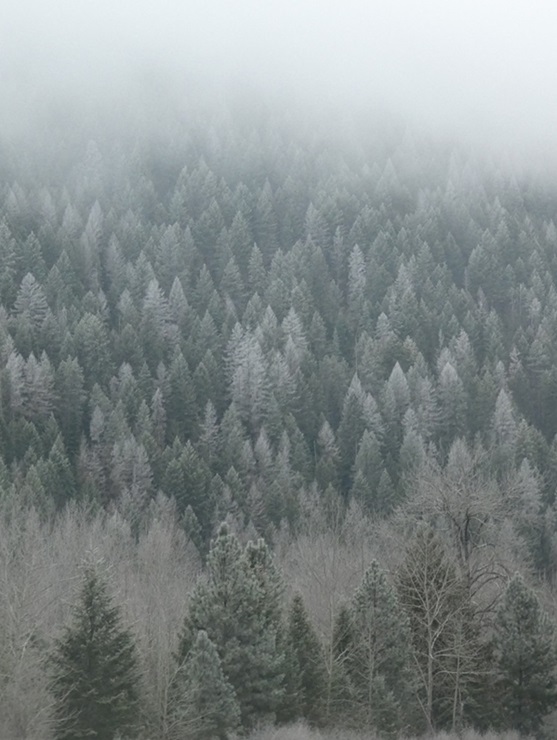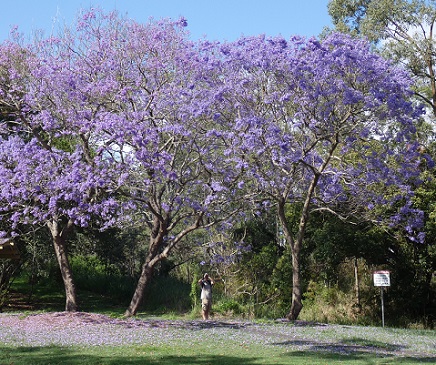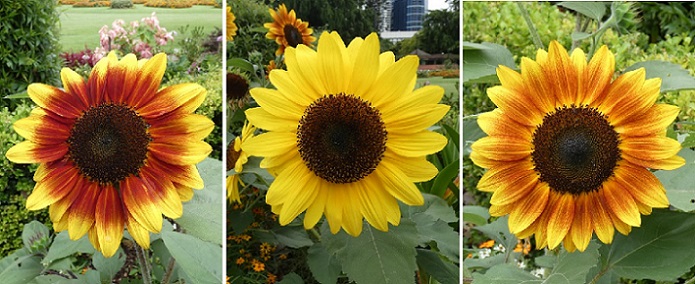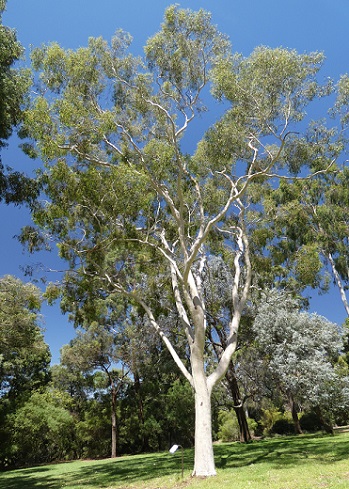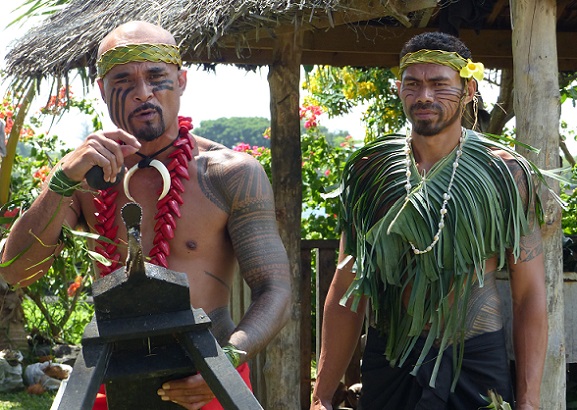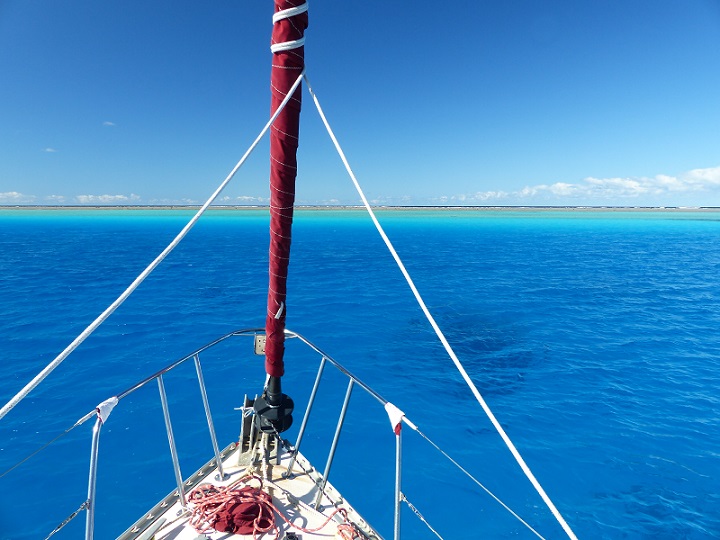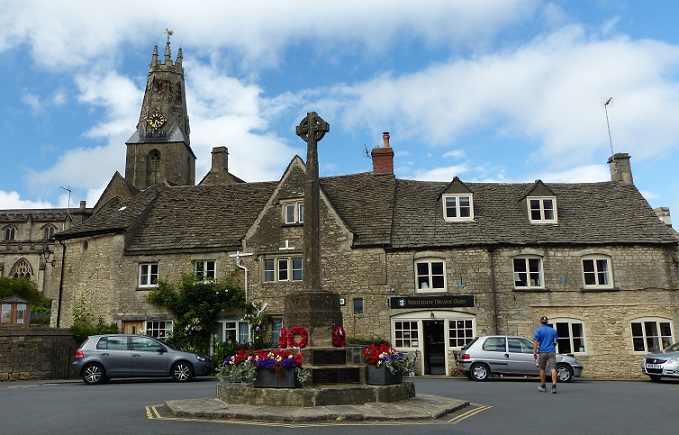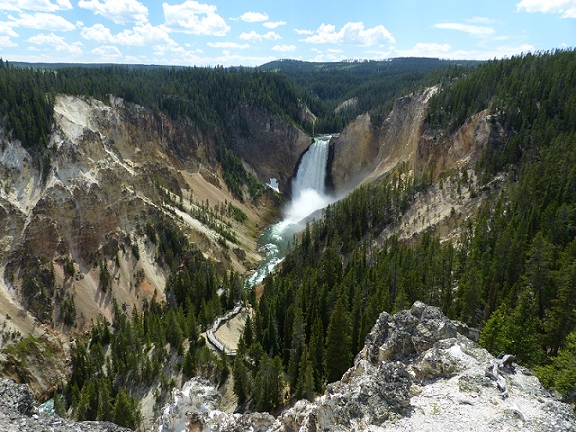
Tregoning
12 April 2024 | We are back aboard Tregoning in Mersin Marina, Mersin, Türkiye
02 April 2024 | We are in Toronto Airport, Canada: Tregoning is in Mersin Marina, Mersin, Türkiye
25 February 2024 | We are back in Gainesville, FL: Tregoning is in Mersin Marina, Mersin, Türkiye
18 February 2024 | We are in Glenwood, New Mexico: Tregoning is in Mersin Marina, Mersin, Türkiye
12 February 2024 | We are in Morro Bay, California: Tregoning is in Mersin Marina, Mersin, Türkiye
19 January 2024 | We are in Vancouver, BC Canada: Tregoning is in Mersin Marina, Mersin, Türkiye
01 January 2024 | We are in Washington State: Tregoning is in Mersin Marina, Mersin, Türkiye
15 December 2023 | We are in Minnesota: Tregoning is in Mersin Marina, Mersin, Türkiye
18 November 2023 | We are in Florida: Tregoning is in Mersin Marina, Mersin, Türkiye
29 October 2023 | We're in Florida - Tregoning is at B-dock, Mersin Marina, Mersin, Türkiye
21 October 2023 | 7 Oda Kapadokya Cave Hotel, Ürgüp, Türkiye
14 October 2023 | Hotel Aşikoğlu, Boğazkale, Türkiye
07 October 2023 | B-dock, Mersin Marina, Mersin, Türkiye
19 September 2023 | “Chez Jon & Angela”, Near Otterton, Devon, UK
14 September 2023 | Airbnb in Fortuneswell on the Isle of Portland, Dorset, UK
11 September 2023 | With Mike, Grange-over-Sands, Cumbria, UK
03 September 2023 | Ardington House, Ardington, Oxfordshire, UK
24 August 2023 | Near "Chez Joan and Peter", College of Roseisle, Moray, Scotland
11 August 2023 | Andrew's house (not exactly), Lichfield, UK
22 July 2023 | Chez Gail, near the New York Café, Budapest, Hungary
Galle and its Fortress
28 January 2023 | Yacht Basin in Galle Harbour, Sri Lanka
Alison Stocker | Photo: L to R: Meeran Mosque (1904), lighthouse (1938), and seawall at Galle Fort
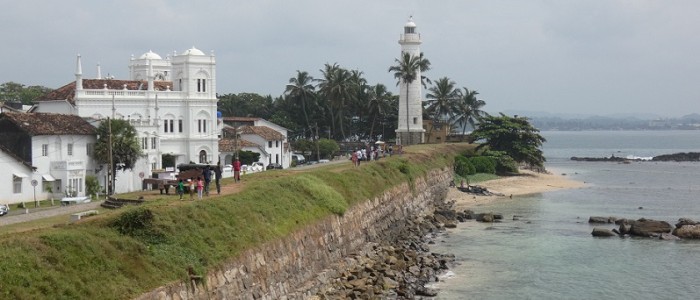
Our time in Galle was dominated by getting Tregoning back into condition for our next ocean passages. Getting the sails repaired was one major project, along with replenishing the diesel that we had to use unexpectedly. Our agent, Uresh, organized this for us because there were limits as to how much fuel most people can buy at once, and to be brought into the Navy Base it inevitably needed Customs paperwork. It cost us 63,000 rupees for 120L (about US$1.50 per L or US$5.80 per US gallon) which was not cheap, but we were glad to get it. If the wind is weak on the way to Djibouti, we will need to be well-stocked with fuel. It is available in the Maldives but is probably more expensive.
In addition to the numerous other boat chores, we were able to take a bit of time to do some sightseeing. The two major goals for us were to see Galle Fort and to go inland to one of the National Parks or Forest Reserves to look for wildlife. So, on Friday morning (27th January), we asked Pahan to take us in his tuktuk to the entrance of the Galle Fort. We enjoyed an excellent day exploring the Fort, including lunch followed by delicious homemade ice-creams at Dairy King! Since it is time to make a quick review of the history of Sri Lanka and Galle, it will be illustrated by pictures from our day at the Fort.
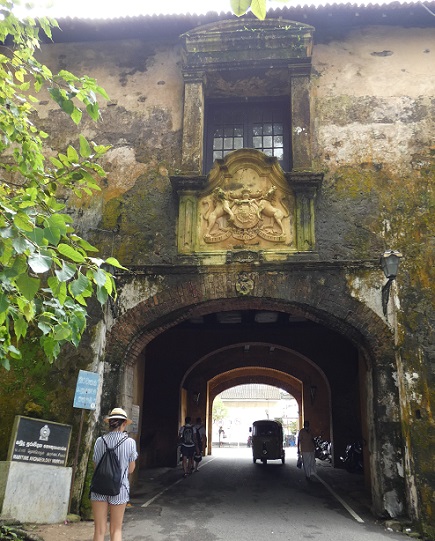
The oldest of two gates into the Fort was completed by the Dutch in 1669. Over the gate is the elaborate coat of arms of King George III with a stone dated 1668 and a small VOC (Dutch East India Company) emblem below.
Although Sri Lanka is not a country that I know much about, it does have a soft spot in my heart for a rather obscure reason. In the last years of his life, my father started writing his "reminiscences" although he did not get very far before he stopped for some reason. The final story of this memoir was of his posting to a Royal Navy ship at the end of World War II. He was to meet the ship in Trincomalee, Sri Lanka. He arrived there on a troopship a few weeks before his assigned vessel arrived, so he was able to travel around the country a bit, although not, as far as I can tell, to Galle. I never talked to him about Sri Lanka, which is a pity, but his brief written statements about it projected a certain fondness, although almost anywhere must have seemed much more attractive as the war was coming to an end.
Formerly known as Ceylon, the Democratic Socialist Republic of Sri Lanka has a population of around 22 million. It is a multicultural state with the Sinhalese comprising the majority of the population (75 %) but with large minorities of Tamils, Moors (Muslims), Malays, Chinese, and indigenous Vedda. Despite the Hindu majority of Sri Lanka's nearest neighbor, India, Buddhism is the major religion in Sri Lanka (70%) followed by Hinduism (13%), Islam (10%), and Christianity (7%). The official languages are Sinhala and Tamil although many people understand some English. The system of government is a "Unitary semi-presidential republic" with a President, Prime Minister, Cabinet, and a single house of Parliament. The President is the elected Head of State, while the Prime Minister is the leader of the majority party elected to Parliament.
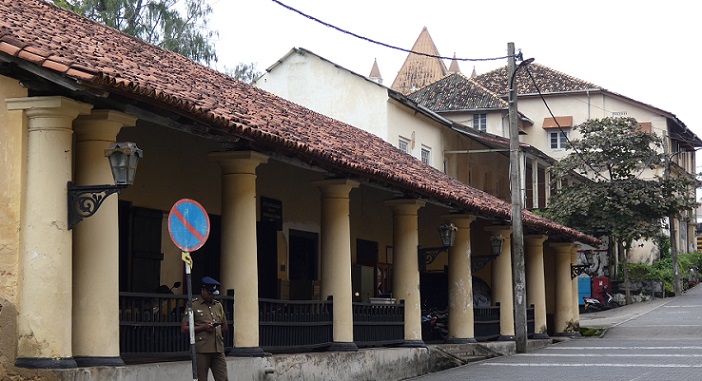
Dutch colonial-style buildings inside the Galle Fort with terracotta tiles, verandas, and many columns. Several of these types of buildings currently house the Provincial Courts and associated magistrates' courts and law offices.
The teardrop-shaped Island is 65,610 km2 (25,330 sq mi) in area, with most of its mountains in the central southern region, the highest point being Pidurutalagala which is 2,524 m (8,281 ft) above sea level. The climate is tropical although frosts may occur in the central highlands and wet monsoon winds blow from the Indian Ocean and Bay of Bengal. This results in a large area of tropical rainforest in the southwest part of the Island, and tropical savannah across the northern part. Rather strangely, the time zone for Sri Lanka is UTC + 5.5 hours.
Prehistoric remains have been found in Sri Lanka that suggest that there has been human habitation for 125,000 years, possibly as far back as 500,000 years. The Island's documented history stretches back 3,000 years, and its deep harbors and position between Europe and Southeast Asia made it an important trading hub, from the days of the ancient Silk Road trade route to the modern maritime route to and from the Malacca Strait.
Throughout history, the Island has been the base of many kingdoms and has been invaded many times, usually from India. In these different eras, the capital city has had various locations, but the legislative capital is now Sri Jayawardenepura Kotte, commonly known as Kotte, which is essentially a suburb of the nation's largest city, Colombo.
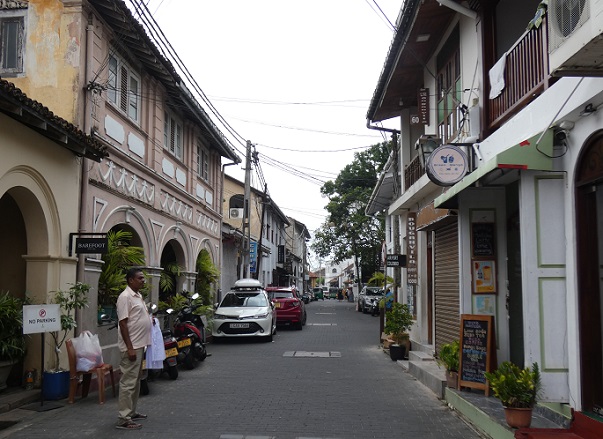
The narrow streets within the urban part of Galle Fort are organized in a grid design. Many buildings have been attractively restored and are now residences, hotels, restaurants, and stores.
The early modern period of Sri Lankan history started with the arrival of a Portuguese explorer, Lourenço de Almeida, when his fleet of ships were blown off their course to the Maldives during a storm in 1505. Various kingdoms survived after the arrival of the Portuguese, with the final independent monarchy, the Kingdom of Kandy, coming to an end in 1739. The colonization of the Island by various European powers is reflected in the history of Galle and its Fort.
Located 119 km (74 miles) south of Colombo, to which is it connected by a railway and a major highway, Galle is the largest and capital city of the Southern Province. Galle's
population of 101,749 is mostly of Sinhalese ethnicity (66%), with a large population (30%) of Sri Lankan Moors (Muslims) descended from Arab merchants who had settled in the ancient port.
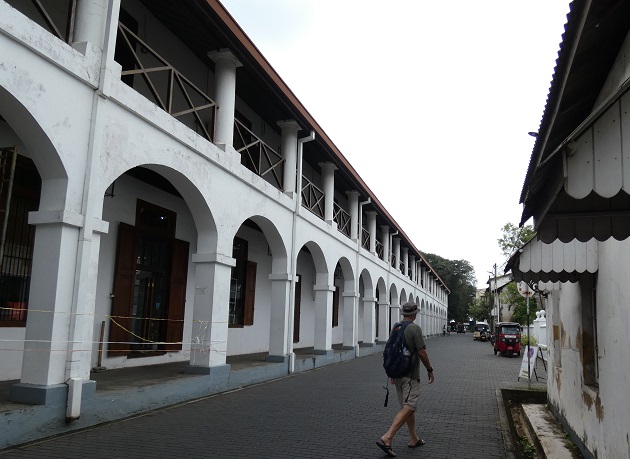
The former Dutch Hospital was extensively restored and reopened in 2014 with up-market restaurants and shops.
Galle may have been known by ancient Greeks and Romans which might have called it the Cape of Birds. It was a major seaport for many centuries, with Persians, Arabs, Greeks, Romans, Malays, Indians, and Chinese doing business there. Items of trade from Sri Lanka included ivory, peacocks, and cinnamon. "In 1411, the Galle Trilingual Inscription, a stone tablet inscription in three languages, Chinese, Tamil and Persian, was erected in Galle to commemorate the second visit to Ceylon by the Chinese admiral Zheng He" (about whom we learned so much in the museum in Melaka, Malaysia - quoted section from Wikipedia).
After the arrival of the Portuguese in Galle in 1505, they started to take over the coastal areas, building forts in Colombo in 1517 and in Galle in 1541. The Galle fort, built on the northern peninsular overlooking the entrance to Galle Bay, consisted of earthworks supported by palisades on the north side, and initially contained a Franciscan monastery. It was later used as a prison camp for Sinhalese natives who opposed the Portuguese. It was strengthened in 1588 to protect the important harbor after an attack by the Sinhalese from inland.
By 1638, the Sinhalese king who still ruled from the inland city of Kandy, signed a treaty with the Dutch East India Company to remove the Portuguese from the coastal areas. "The following Dutch-Portuguese War resulted in a Dutch victory, with Colombo falling into Dutch hands by 1656. The Dutch remained in the areas they had captured, thereby violating the treaty they had signed in 1638. The Burgher people, a distinct ethnic group, emerged as a result of intermingling between the Dutch and native Sri Lankans in this period." (From Wikipedia.)
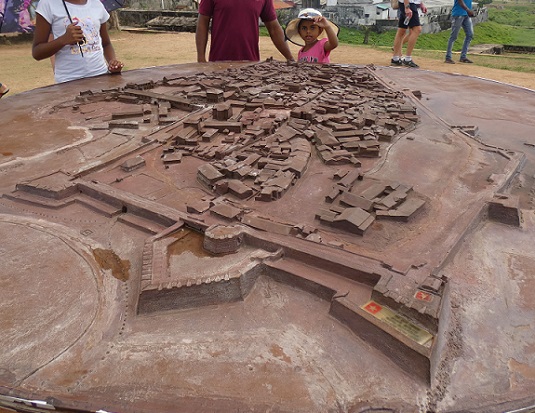
A model of Galle Fort, seen from its northwest corner showing the main urban area in the southeastern area.
The Dutch massively expanded the Galle Fort from the mid-17th century until the early 18th century, building a fortified coral and granite seawall that encircled the entire peninsular. It had 14 bastions, the largest three of which were known as the "Sun", "Moon" and "Star". "The establishment consisted of public administration buildings, warehouses, and business houses, and residential quarters. A Protestant church (planned by Abraham Anthonisz) was also built in baroque style in 1775 to cater to the colonists and the local people who were converted to Christianity. The most prominent buildings in the fort complex were the Commandant's residence, the arsenal and the gun house. Other buildings erected in the fort catered to trade and defense requirements such as workshops for carpentry, smithy, rope making, and so forth. They also built an elaborate system of sewers that were flooded at high tide, taking the sewage away to sea." (From Wikipedia.)
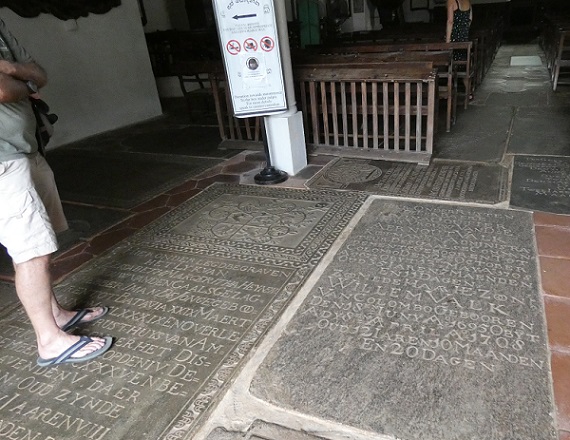
A Dutch Reformed Church was built in 1640 but was completely remodeled between 1752 and 1755. The church is paved with gravestones from the old Dutch cemetery.
In 1796, during the Napoleonic Wars, Great Britain occupied the coastal areas of the Island because they were afraid that once the French controlled the Netherlands, they would take over Ceylon as well. Within two years, the entire coastal area was under the control of the British East India Company, and in February 1815 Kandy was occupied by the British in the second Kandyan War, ending Sri Lanka's independence and making it a colony of Great Britain. The British developed Colombo as their capital and main port, so the importance of Galle declined. Sri Lanka became an independent nation again after World War II on 4 February 1948.
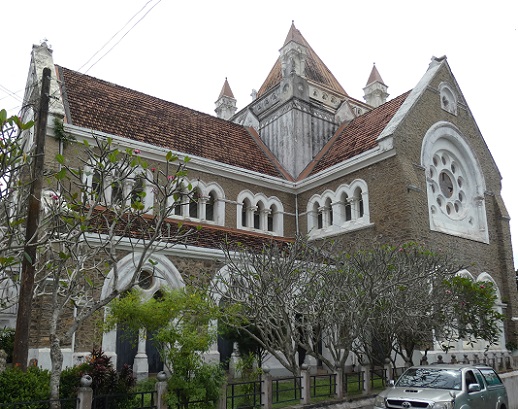
The Anglican All Saints Church build in 1871 and restored after the 2004 Boxing Day Tsunami
The British used Galle Fort as the administrative center of the district. They also modified it, "such as closing the moat, building houses, a lighthouse on the Utrecht Bastion, a gate between the Moon Bastion and the Sun Bastion. A tower was erected in 1883 to commemorate the jubilee of Queen Victoria. The Second World War saw many more fortifications built to defend the fort." (From Wikipedia.) Extensive reconstruction work done by the Archaeological Department of Sri Lanka has allowed the area to maintain its "polished" appearance. It has been recognized as a UNESCO World Heritage Site described as having "an urban ensemble which illustrates the interaction of European architecture and South Asian traditions from the 16th to the 19th centuries." The town within the fort continues to have a multiethnic and multireligious population including many buildings still being owned by Dutch people. It currently covers an area of 52 hectares (130 acres). Galle Fort is the largest remaining fortress in Asia built by European occupiers and is considered to be "the best example of a fortified city...in South and Southeast Asia" (Wikipedia).
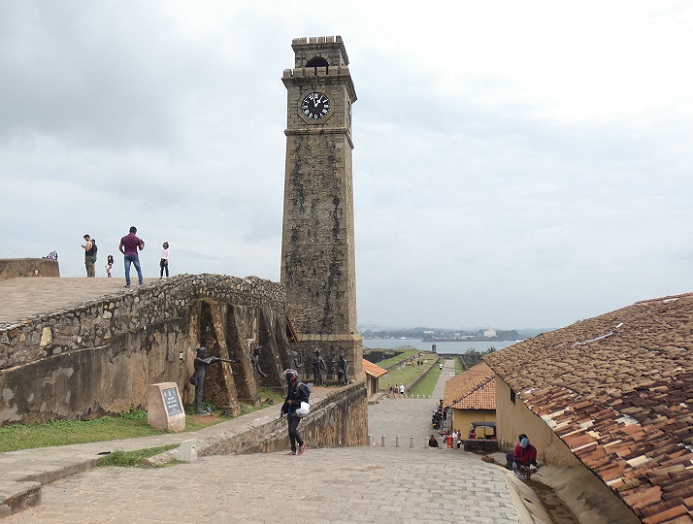
Clock tower built in 1883 on the Moon Bastion of the Fort's northern wall
In Sri Lanka, the 2004 Boxing Day Tsunami (which killed 225,000 people worldwide) caused 31,229 confirmed deaths, 4,093 missing, 21,411 injured, and 1.5 million people displaced from their homes. Galle was one of the worst devastated cities where thousands of people were killed. Alongside Galle Fort, which survived the tsunami quite well, is the Galle International Stadium, where test matches are held and which is considered to be one of the most picturesque cricket grounds in the world. The Stadium was completely ruined by the tsunami but has now been restored, largely due to the support of the international cricketing community, with test matches resuming in 2007.

View northeast from the Fort with the cricket oval of the Galle International Stadium on the left
In addition to wandering along most of the seawalls and several of the enclosed streets, we visited a private museum, part of which was also a jewelry store. There seemed to be a disproportionate number of gem and jewelry stores inside the Fort, presumably because this is where tourists (especially cruise ship passengers) are most likely to visit...and spend money. Within the Fort there were also several high-quality hotels, guesthouses, and restaurants, along with art galleries and high-end clothing stores.
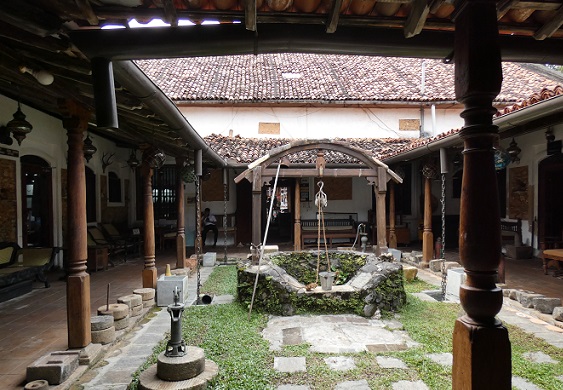
The inner courtyard and freshwater well in the "Historical Mansion Museum Arcade"
The museum contained the massed findings of a single collector and was stuffed with an eclectic range of items from ancient pottery, to historic weapons, to an assortment of electric toasters. The items were not individually labelled and there was no "story" to tie them together in any way, so our visit was brief. The items that most interested me were some manuscripts made into narrow "books" that were made of ola leaf, a type of palm leaf. Fortunes were written on these manuscripts and were used for many centuries.
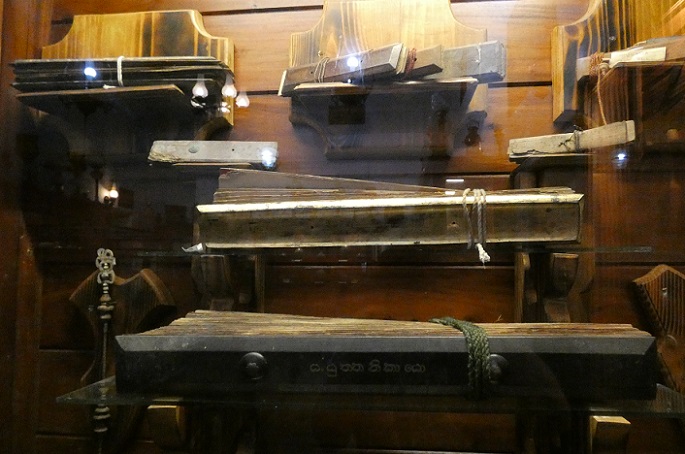
Ola leaf manuscripts in narrow "books" bound with wood and string
The text was written using Sinhala letters which are a very rounded, in fact, it is the most circular of the Indic scripts. This was probably because, unlike chiseling on rock, when writing on palm leaves, straight lines, sharp points, or stops would cause the leaves to tear. Thus, this script, written from left to right, evolved without full-stops (periods) and commas. There are 58 letters in the Sinhala alphabet but only 38 are used commonly.
Walking along the Forts seawalls and watching the sunset is a popular activity for locals and visitors alike. It was just a couple of nights before we were due to leave by the time we actually decided to do this. Unfortunately, we ended up selecting an evening with a thunderstorm and heavy rain, a parting gift from a non-cyclone as it swept off to the southwest. Thus, there was no sunset to be seen, and any idea of carefree wandering around the Fort was quickly washed away. We did, however, have a fabulous Sri Lankan dinner at the tiny Lucky Fort Restaurant. My mango Lassi (yoghurt smoothie) was heavenly and we shared a large plate of rice with small dishes of 10 different curries (not very hot) including ones made with chicken, jackfruit, beets, sweet potatoes, dahl, banana flowers, or eggplant. A 15-minute power-cut in the middle did not bother the hosts at all as candles were lit and distributed to the tables.
We had eaten lunch one day at a dining room close to the Navy Base that clearly also served authentic Sri Lankan food. It was very hotly spiced (necessitating the subsequent consumption of cooling ice-creams) and, quite frankly, was not something that I needed to repeat. Thus, the milder but flavorful meal at the Lucky Fort Restaurant was a welcome education that not all Sri Lankan food needs to be tastebud melting. It made the perfect ending to our exploration of Galle Fort.
In addition to the numerous other boat chores, we were able to take a bit of time to do some sightseeing. The two major goals for us were to see Galle Fort and to go inland to one of the National Parks or Forest Reserves to look for wildlife. So, on Friday morning (27th January), we asked Pahan to take us in his tuktuk to the entrance of the Galle Fort. We enjoyed an excellent day exploring the Fort, including lunch followed by delicious homemade ice-creams at Dairy King! Since it is time to make a quick review of the history of Sri Lanka and Galle, it will be illustrated by pictures from our day at the Fort.

The oldest of two gates into the Fort was completed by the Dutch in 1669. Over the gate is the elaborate coat of arms of King George III with a stone dated 1668 and a small VOC (Dutch East India Company) emblem below.
Although Sri Lanka is not a country that I know much about, it does have a soft spot in my heart for a rather obscure reason. In the last years of his life, my father started writing his "reminiscences" although he did not get very far before he stopped for some reason. The final story of this memoir was of his posting to a Royal Navy ship at the end of World War II. He was to meet the ship in Trincomalee, Sri Lanka. He arrived there on a troopship a few weeks before his assigned vessel arrived, so he was able to travel around the country a bit, although not, as far as I can tell, to Galle. I never talked to him about Sri Lanka, which is a pity, but his brief written statements about it projected a certain fondness, although almost anywhere must have seemed much more attractive as the war was coming to an end.
Formerly known as Ceylon, the Democratic Socialist Republic of Sri Lanka has a population of around 22 million. It is a multicultural state with the Sinhalese comprising the majority of the population (75 %) but with large minorities of Tamils, Moors (Muslims), Malays, Chinese, and indigenous Vedda. Despite the Hindu majority of Sri Lanka's nearest neighbor, India, Buddhism is the major religion in Sri Lanka (70%) followed by Hinduism (13%), Islam (10%), and Christianity (7%). The official languages are Sinhala and Tamil although many people understand some English. The system of government is a "Unitary semi-presidential republic" with a President, Prime Minister, Cabinet, and a single house of Parliament. The President is the elected Head of State, while the Prime Minister is the leader of the majority party elected to Parliament.

Dutch colonial-style buildings inside the Galle Fort with terracotta tiles, verandas, and many columns. Several of these types of buildings currently house the Provincial Courts and associated magistrates' courts and law offices.
The teardrop-shaped Island is 65,610 km2 (25,330 sq mi) in area, with most of its mountains in the central southern region, the highest point being Pidurutalagala which is 2,524 m (8,281 ft) above sea level. The climate is tropical although frosts may occur in the central highlands and wet monsoon winds blow from the Indian Ocean and Bay of Bengal. This results in a large area of tropical rainforest in the southwest part of the Island, and tropical savannah across the northern part. Rather strangely, the time zone for Sri Lanka is UTC + 5.5 hours.
Prehistoric remains have been found in Sri Lanka that suggest that there has been human habitation for 125,000 years, possibly as far back as 500,000 years. The Island's documented history stretches back 3,000 years, and its deep harbors and position between Europe and Southeast Asia made it an important trading hub, from the days of the ancient Silk Road trade route to the modern maritime route to and from the Malacca Strait.
Throughout history, the Island has been the base of many kingdoms and has been invaded many times, usually from India. In these different eras, the capital city has had various locations, but the legislative capital is now Sri Jayawardenepura Kotte, commonly known as Kotte, which is essentially a suburb of the nation's largest city, Colombo.

The narrow streets within the urban part of Galle Fort are organized in a grid design. Many buildings have been attractively restored and are now residences, hotels, restaurants, and stores.
The early modern period of Sri Lankan history started with the arrival of a Portuguese explorer, Lourenço de Almeida, when his fleet of ships were blown off their course to the Maldives during a storm in 1505. Various kingdoms survived after the arrival of the Portuguese, with the final independent monarchy, the Kingdom of Kandy, coming to an end in 1739. The colonization of the Island by various European powers is reflected in the history of Galle and its Fort.
Located 119 km (74 miles) south of Colombo, to which is it connected by a railway and a major highway, Galle is the largest and capital city of the Southern Province. Galle's
population of 101,749 is mostly of Sinhalese ethnicity (66%), with a large population (30%) of Sri Lankan Moors (Muslims) descended from Arab merchants who had settled in the ancient port.

The former Dutch Hospital was extensively restored and reopened in 2014 with up-market restaurants and shops.
Galle may have been known by ancient Greeks and Romans which might have called it the Cape of Birds. It was a major seaport for many centuries, with Persians, Arabs, Greeks, Romans, Malays, Indians, and Chinese doing business there. Items of trade from Sri Lanka included ivory, peacocks, and cinnamon. "In 1411, the Galle Trilingual Inscription, a stone tablet inscription in three languages, Chinese, Tamil and Persian, was erected in Galle to commemorate the second visit to Ceylon by the Chinese admiral Zheng He" (about whom we learned so much in the museum in Melaka, Malaysia - quoted section from Wikipedia).
After the arrival of the Portuguese in Galle in 1505, they started to take over the coastal areas, building forts in Colombo in 1517 and in Galle in 1541. The Galle fort, built on the northern peninsular overlooking the entrance to Galle Bay, consisted of earthworks supported by palisades on the north side, and initially contained a Franciscan monastery. It was later used as a prison camp for Sinhalese natives who opposed the Portuguese. It was strengthened in 1588 to protect the important harbor after an attack by the Sinhalese from inland.
By 1638, the Sinhalese king who still ruled from the inland city of Kandy, signed a treaty with the Dutch East India Company to remove the Portuguese from the coastal areas. "The following Dutch-Portuguese War resulted in a Dutch victory, with Colombo falling into Dutch hands by 1656. The Dutch remained in the areas they had captured, thereby violating the treaty they had signed in 1638. The Burgher people, a distinct ethnic group, emerged as a result of intermingling between the Dutch and native Sri Lankans in this period." (From Wikipedia.)

A model of Galle Fort, seen from its northwest corner showing the main urban area in the southeastern area.
The Dutch massively expanded the Galle Fort from the mid-17th century until the early 18th century, building a fortified coral and granite seawall that encircled the entire peninsular. It had 14 bastions, the largest three of which were known as the "Sun", "Moon" and "Star". "The establishment consisted of public administration buildings, warehouses, and business houses, and residential quarters. A Protestant church (planned by Abraham Anthonisz) was also built in baroque style in 1775 to cater to the colonists and the local people who were converted to Christianity. The most prominent buildings in the fort complex were the Commandant's residence, the arsenal and the gun house. Other buildings erected in the fort catered to trade and defense requirements such as workshops for carpentry, smithy, rope making, and so forth. They also built an elaborate system of sewers that were flooded at high tide, taking the sewage away to sea." (From Wikipedia.)

A Dutch Reformed Church was built in 1640 but was completely remodeled between 1752 and 1755. The church is paved with gravestones from the old Dutch cemetery.
In 1796, during the Napoleonic Wars, Great Britain occupied the coastal areas of the Island because they were afraid that once the French controlled the Netherlands, they would take over Ceylon as well. Within two years, the entire coastal area was under the control of the British East India Company, and in February 1815 Kandy was occupied by the British in the second Kandyan War, ending Sri Lanka's independence and making it a colony of Great Britain. The British developed Colombo as their capital and main port, so the importance of Galle declined. Sri Lanka became an independent nation again after World War II on 4 February 1948.

The Anglican All Saints Church build in 1871 and restored after the 2004 Boxing Day Tsunami
The British used Galle Fort as the administrative center of the district. They also modified it, "such as closing the moat, building houses, a lighthouse on the Utrecht Bastion, a gate between the Moon Bastion and the Sun Bastion. A tower was erected in 1883 to commemorate the jubilee of Queen Victoria. The Second World War saw many more fortifications built to defend the fort." (From Wikipedia.) Extensive reconstruction work done by the Archaeological Department of Sri Lanka has allowed the area to maintain its "polished" appearance. It has been recognized as a UNESCO World Heritage Site described as having "an urban ensemble which illustrates the interaction of European architecture and South Asian traditions from the 16th to the 19th centuries." The town within the fort continues to have a multiethnic and multireligious population including many buildings still being owned by Dutch people. It currently covers an area of 52 hectares (130 acres). Galle Fort is the largest remaining fortress in Asia built by European occupiers and is considered to be "the best example of a fortified city...in South and Southeast Asia" (Wikipedia).

Clock tower built in 1883 on the Moon Bastion of the Fort's northern wall
In Sri Lanka, the 2004 Boxing Day Tsunami (which killed 225,000 people worldwide) caused 31,229 confirmed deaths, 4,093 missing, 21,411 injured, and 1.5 million people displaced from their homes. Galle was one of the worst devastated cities where thousands of people were killed. Alongside Galle Fort, which survived the tsunami quite well, is the Galle International Stadium, where test matches are held and which is considered to be one of the most picturesque cricket grounds in the world. The Stadium was completely ruined by the tsunami but has now been restored, largely due to the support of the international cricketing community, with test matches resuming in 2007.

View northeast from the Fort with the cricket oval of the Galle International Stadium on the left
In addition to wandering along most of the seawalls and several of the enclosed streets, we visited a private museum, part of which was also a jewelry store. There seemed to be a disproportionate number of gem and jewelry stores inside the Fort, presumably because this is where tourists (especially cruise ship passengers) are most likely to visit...and spend money. Within the Fort there were also several high-quality hotels, guesthouses, and restaurants, along with art galleries and high-end clothing stores.

The inner courtyard and freshwater well in the "Historical Mansion Museum Arcade"
The museum contained the massed findings of a single collector and was stuffed with an eclectic range of items from ancient pottery, to historic weapons, to an assortment of electric toasters. The items were not individually labelled and there was no "story" to tie them together in any way, so our visit was brief. The items that most interested me were some manuscripts made into narrow "books" that were made of ola leaf, a type of palm leaf. Fortunes were written on these manuscripts and were used for many centuries.

Ola leaf manuscripts in narrow "books" bound with wood and string
The text was written using Sinhala letters which are a very rounded, in fact, it is the most circular of the Indic scripts. This was probably because, unlike chiseling on rock, when writing on palm leaves, straight lines, sharp points, or stops would cause the leaves to tear. Thus, this script, written from left to right, evolved without full-stops (periods) and commas. There are 58 letters in the Sinhala alphabet but only 38 are used commonly.
Walking along the Forts seawalls and watching the sunset is a popular activity for locals and visitors alike. It was just a couple of nights before we were due to leave by the time we actually decided to do this. Unfortunately, we ended up selecting an evening with a thunderstorm and heavy rain, a parting gift from a non-cyclone as it swept off to the southwest. Thus, there was no sunset to be seen, and any idea of carefree wandering around the Fort was quickly washed away. We did, however, have a fabulous Sri Lankan dinner at the tiny Lucky Fort Restaurant. My mango Lassi (yoghurt smoothie) was heavenly and we shared a large plate of rice with small dishes of 10 different curries (not very hot) including ones made with chicken, jackfruit, beets, sweet potatoes, dahl, banana flowers, or eggplant. A 15-minute power-cut in the middle did not bother the hosts at all as candles were lit and distributed to the tables.
We had eaten lunch one day at a dining room close to the Navy Base that clearly also served authentic Sri Lankan food. It was very hotly spiced (necessitating the subsequent consumption of cooling ice-creams) and, quite frankly, was not something that I needed to repeat. Thus, the milder but flavorful meal at the Lucky Fort Restaurant was a welcome education that not all Sri Lankan food needs to be tastebud melting. It made the perfect ending to our exploration of Galle Fort.
Comments
| Vessel Name: | Tregoning |
| Vessel Make/Model: | Morgan Classic 41 |
| Hailing Port: | Gainesville, FL |
| Crew: | Alison and Randall |
| About: | We cast-off from Fernandina Beach in north Florida on 1st June 2008 and we have been cruising on Tregoning ever since. Before buying Tregoning, both of us had been sailing on smaller boats for many years and had worked around boats and water throughout our careers. |
| Extra: | “Tregoning” (rhymes with “belonging”) and is a Cornish word (meaning “homestead of Cohnan” or “farm by the ash trees”) and was Alison's mother’s middle name. Cornwall is in southwest England and is where Alison grew-up. |
Tregoning's Photos - Main
 |
Extra photographs from our three-week campervan tour of the South Island from November 15th to December 5th 2015
217 Photos
Created 4 January 2016
|
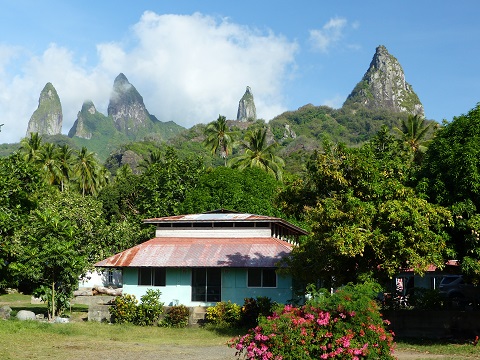 |
Random pictures from our month spent on the islands of Hiva Oa, Tahuata, Ua Pou, and Nuku Hiva
45 Photos
Created 18 July 2015
|
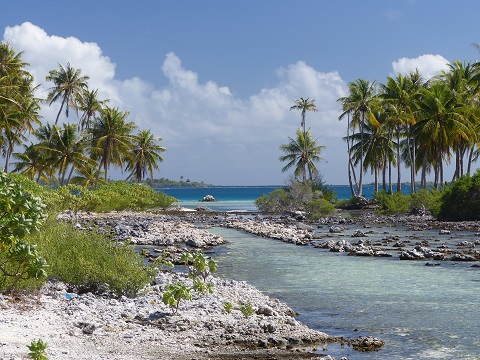 |
Random pictures from our month spent in 4 Tuamotu Atolls; Ahe, Fakarava, Tahanea, and Toau
32 Photos
Created 1 July 2015
|
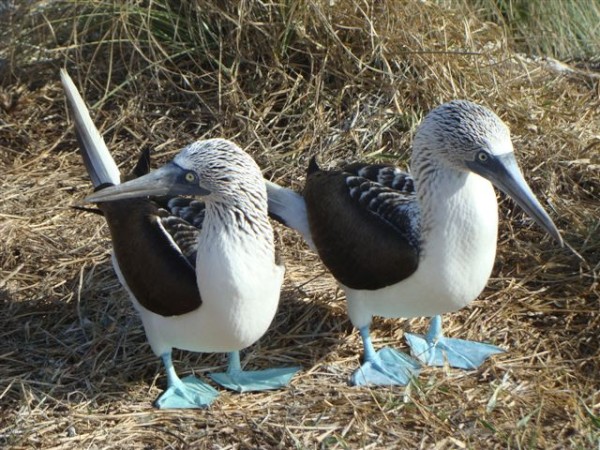 |
Some of the birds, fish, reptiles, and mammals (and others) that we have seen in Mexico
74 Photos
Created 5 May 2014
|
Tregoning

Who: Alison and Randall
Port: Gainesville, FL
